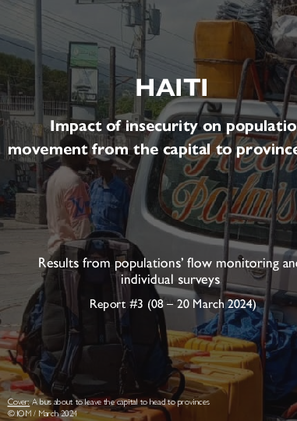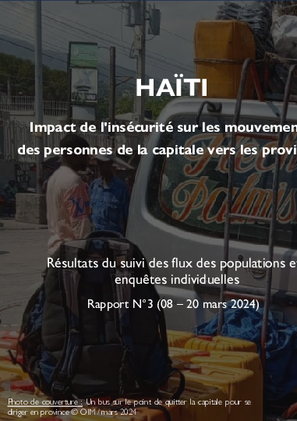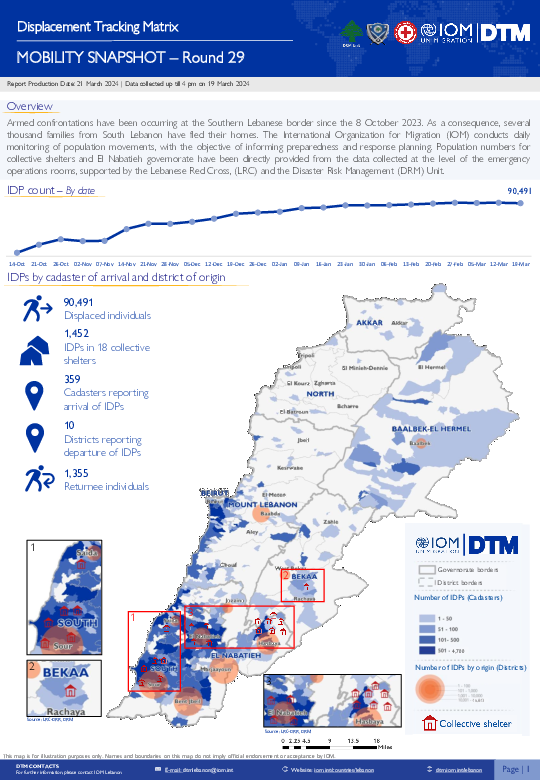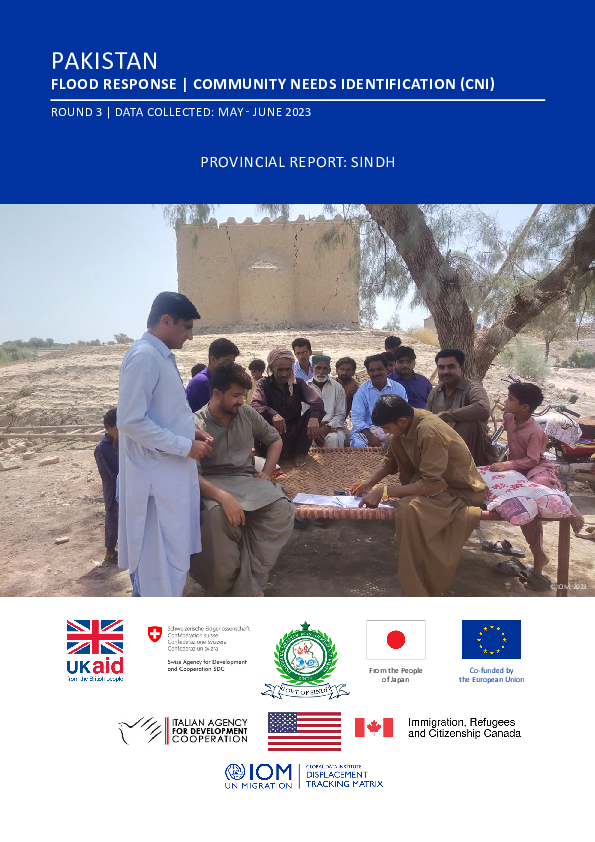-
Countries
-
Data and Analysis
-
Special Focus
-
Crisis Responses

Contact
DTM Haiti, dtmhaiti@iom.int
Language
English
Location
Haiti
Period Covered
Mar 08 2024
Mar 20 2024
Activity
- Survey
- Flow Monitoring Survey
- Flow Monitoring
In recent weeks, armed attacks have intensified in the Metropolitan Area of Port-Au-Prince (MAPAP), the capital of Haiti. In addition to creating displacement within the MAPAP, attacks and generalized insecurity are pushing more and more people to leave the capital to find refuge in provinces, taking the risks of passing through gangs-controlled routes. In order to monitor these movements towards provinces and inform appropriate response strategies, DTM has launched data collection at several of the most used bus stations in the capital (see page 5 for more details on the methodology). Since the start of this activity, on 8 March, until 20 March, this activity allowed to observe the movements of 33,333 people leaving the MAPAP (see pages 3 and 4 for more details on the profile of these people ). The majority of them (62%) took means of transport heading towards the Grand Sud departments (Grande’Anse, South, Nippes and South-East). It should be noted that this region already hosts more than 116,000 people who had in vast majority, fled the MAPAP in recent months (see the report on displacement in the Grand Sud).
It should be emphasized that provinces do not have sufficient infrastructures and host communities do not have sufficient resources that can enable them to cope with these massive displacement flows coming from the capital.

Contact
DTM Haiti, dtmhaiti@iom.int
Language
French
Location
Haiti
Period Covered
Mar 08 2024
Mar 20 2024
Activity
- Survey
- Flow Monitoring Survey
- Flow Monitoring
Depuis quelques semaines, les attaques armées se sont intensifiées dans la Zone Métropolitaine de Port-au-Prince (ZMPP), la capitale d’Haïti. En plus de créer des déplacements à l’intérieur de la ZMPP, les attaques et l’insécurité généralisée poussent de plus en plus de personnes à quitter la capitale pour trouver refuge dans les provinces, en prenant les risques de passer par des routes contrôlées par des gangs. Afin de suivre ces mouvements vers les provinces et informer les stratégies de réponse adéquates, la DTM a lancé des collectes de données au niveau de plusieurs stations de bus les plus utilisées dans la capitale (voir la page 5 pour plus de détails sur la méthodologie). Depuis le début de cette activité, le 08 mars, jusqu’au 20 mars, cette activité a permis d’observer les mouvements de 33 333 personnes quittant la ZMPP (voir les pages 3 et 4 pour plus de détails sur le profil de ces personnes). Ces personnes ont en majorité (62%) pris des moyens de transport se dirigeant vers les départements du Grand Sud (Grande’Anse, Sud, Nippes et Sud-Est). Il est à noter que cette région accueille déjà plus 116 000 personnes qui avaient en grande partie fui la ZMPP durant des mois passés (voir le rapport sur les déplacements dans le Grand Sud).
Il convient de souligner que les provinces n’ont pas suffisamment d’infrastructures et les communautés hôtes n’ont pas de ressources suffisantes qui peuvent leur permettre de faire face à ces flux de déplacements massifs venant de la capitale.
Contact
DTM Sudan, DTMSudan@iom.int
Location
Sudan
Activity
- Mobility Tracking
- Baseline Assessment
Period Covered
Mar 08 2024 -Mar 13 2024
- DTM Sudan estimates that 6,505,486 individuals (1,299,890 households) were recently internally displaced.
- The IDP caseload was observed in 6,991 locations across all of Sudan’s 18 states.
- The highest proportions of IDPs were observed across South Darfur (11%), River Nile (11%), and East Darfur (10%).
- Field teams reported that the IDPs observed were originally displaced from twelve states. The majority (3,556,673 IDPs, 55%) were reportedly displaced from Khartoum state; followed by South Darfur (15%), North Darfur (9%), Aj Jazirah (8%), Central Darfur (4%), West Darfur (4%), South Kordofan (2%), East Darfur (1%), West Kordofan (1%), North Kordofan (1%), Sennar (<1%) and White Nile (<1%).
- IOM-DTM also reported that an estimated 1,955,726 mixed cross-border movements were made into neighbouring countries.
- This product provides brief insights into those displaced in Sudan post-15 April 2023. For more granular information on the IDP caseload and the displacement context, please see IOM-DTM's Monthly Displacement Overview 06.
A more detailed version of this dataset is available, to get access kindly click on the 'Request Access' button
Population Groups
IDPs
Survey Methodology
Unit of Analysis Or Observation
Site or Location
Type of Survey or Assessment
Key Informant
Keywords
Geographical Scope Partial Coverage
Administrative boundaries with available data
The current dataset covers the following administrative boundaries
Contact
DTMUKRAINE@IOM.INT
Location
Ukraine
Activity
- Mobility Tracking
Period Covered
Jul 01 2023 -Aug 31 2023
During this round of data collection, IOM Ukraine's Data & Analytics Unit conducted assessments in 85 hromadas across 50 raions and 20 oblasts. Assessed hromadas were selected based on their relevance to humanitarian and recovery programming, pre-war population size, and known displacement trends, with a specific focus on areas closer to the frontline.
This is a restricted dataset. To get access, kindly click on the 'Request Access' button.
Population Groups
IDPs
Residents
Returnee (Previously Internally Displaced)
Survey Methodology
Unit of Analysis Or Observation
Admin Area 2
Admin Area 3
Site or Location
Type of Survey or Assessment
Key Informant
Keywords
Geographical Scope Partial Coverage
Administrative boundaries with available data
The current dataset covers the following administrative boundaries
Contact
DTMUkraine@iom.int
Location
Ukraine
Activity
- Survey
- Return Intention
Period Covered
Nov 01 2023 -Dec 31 2023
The Conditions of Return Assessment is a tool designed to measure the population and severity of conditions in locations of return. The assessment is based on 20 indicators divided into 5 ‘drivers’: (1) livelihoods, (2) utilities and services (3) residential destruction, (4) Safety and security, and (5) public life. The indicators describe the critical or minimum conditions required for sustainable return and reintegration in Ukraine. The scores of each indicator and driver are grouped into three categories: low, medium, and high severity of living conditions. For more information on the methodology, please refer to the CoRA Round 6 Report, December 2023.
This is a restricted dataset. To get access, kindly click on the 'Request Access' button.
Population Groups
IDPs
Residents
Returnee (Previously Displaced Abroad)
Returnee (Previously Internally Displaced)
Survey Methodology
Unit of Analysis Or Observation
Admin Area 2
Admin Area 3
Type of Survey or Assessment
Key Informant
Keywords
Geographical Scope Partial Coverage
Administrative boundaries with available data
The current dataset covers the following administrative boundaries

Contact
dtmlebanon@iom.int
Language
English
Location
Lebanon
Period Covered
Oct 10 2023
Mar 19 2024
Activity
- Mobility Tracking
- Baseline Assessment
Since October 8 there has been an increase in cross-border incidents between Israel and Lebanon, resulting in the displacement of people both within the South and elsewhere within the country. Since October 10, the Displacement Tracking Matrix (DTM) has been conducting the daily monitoring of population movements. The objective of the exercise is to inform preparedness and response planning.

Contact
IOMASTANA@iom.int
Language
English
Location
Kazakhstan
Period Covered
Jul 01 2023
Sep 30 2023
Activity
- Survey
- Flow Monitoring Survey
- Flow Monitoring
- Mobility Tracking
The quarterly migration situation report is developed by combining secondary data obtained from different sources, including government agencies, international organizations, non-profit entities, and other types of organizations. More specifically, the report on the third quarter of 2023 was derived from data of the Ministry of Internal Affairs, Bureau of National Statistics, and Border Service of Kazakhstan. The data was compiled through a combination of published sources and direct requests to the partners and government agencies.

Contact
dtmpakistan@iom.int
Language
English
Location
Pakistan
Period Covered
Aug 01 2023
Aug 31 2023
Activity
- Survey
- Mobility Tracking
- Site Assessment
From June to October 2022, storms and heavy monsoon rains in Pakistan caused widespread flooding and landslides across the country. As of 18 November 2022, according to the National Disaster Management Authority (NDMA), up to 33 million people have been affected by the floods and a total of 90 districts have been labelled by the Government of Pakistan as ‘calamity-hit’.
In August 2023, IOM implemented a fourth round of the CNI to provide partners with timely information on the displacement situation, the multisectoral needs of the affected population as well as the recovery needs at the settlement level.11 For this round, IOM implemented the CNI in 11 districts of Sindh. The CNI was conducted in 6,248 flood-affected settlements or settlements that hosted temporary displaced persons (TDPs) across the 11 targeted districts.

Contact
dtmpakistan@iom.int
Language
English
Location
Pakistan
Period Covered
May 01 2023
Jun 30 2023
Activity
- Survey
- Mobility Tracking
- Site Assessment
From June to October 2022, storms and heavy monsoon rains in Pakistan caused widespread flooding and landslides across the country. As of 18 November 2022, according to the National Disaster Management Authority (NDMA), up to 33 million people have been affected by the floods and a total of 90 districts have been labelled by the Government of Pakistan as ‘calamity-hit’.
Between May and June 2023, IOM implemented a third round of the CNI to provide partners with timely information on the displacement situation, the multisectoral needs of the affected population as well as the recovery needs at the settlement level.11 For this round, IOM implemented the CNI in 11 districts of Sindh. The CNI was conducted in 6,172 flood-affected settlements or settlements that hosted temporary displaced persons (TDPs) across the 11 targeted districts.

Contact
DTMUkraine@iom.int
Language
English
Location
Ukraine
Period Covered
Nov 27 2023
Dec 27 2023
Activity
- Survey
The oblast profiles draw from data in the IOM General Population Survey (GPS) round 15, emphasising population demographics and displacement, durable solutions, shelter adequacy, basic needs, employment & income, and social cohesion. These insights, categorised by population group at the oblast level, aim to support evidence-based decision-making on strategic, technical, and programmatic aspects of the humanitarian response and recovery efforts in Ukraine.
